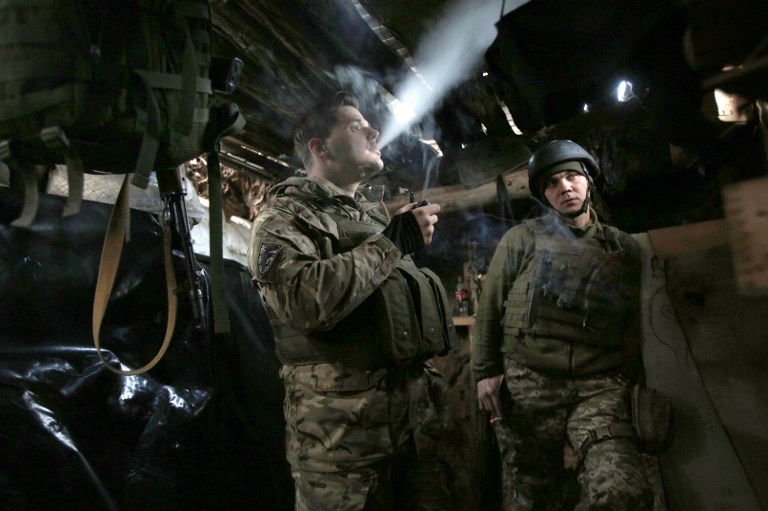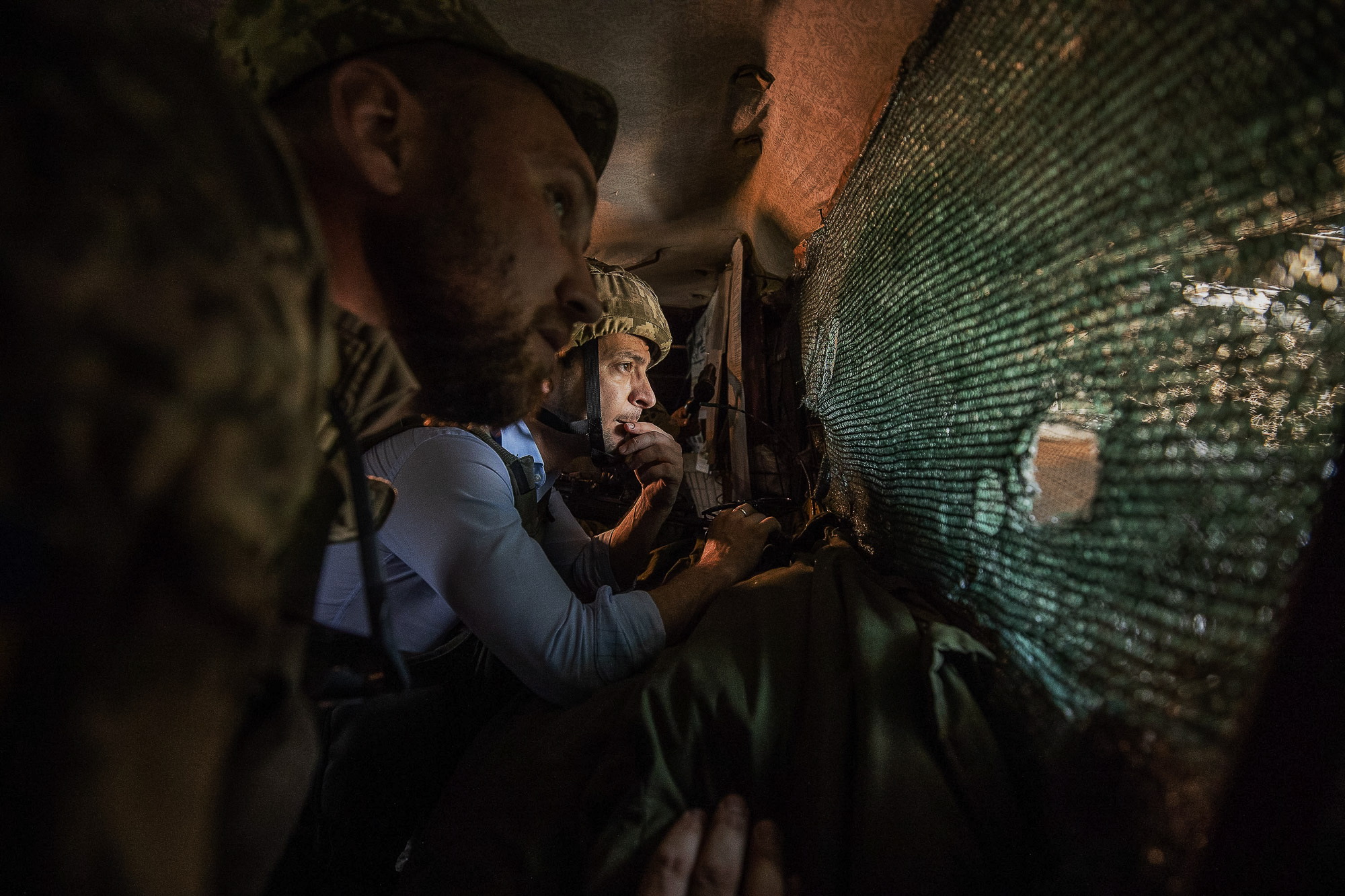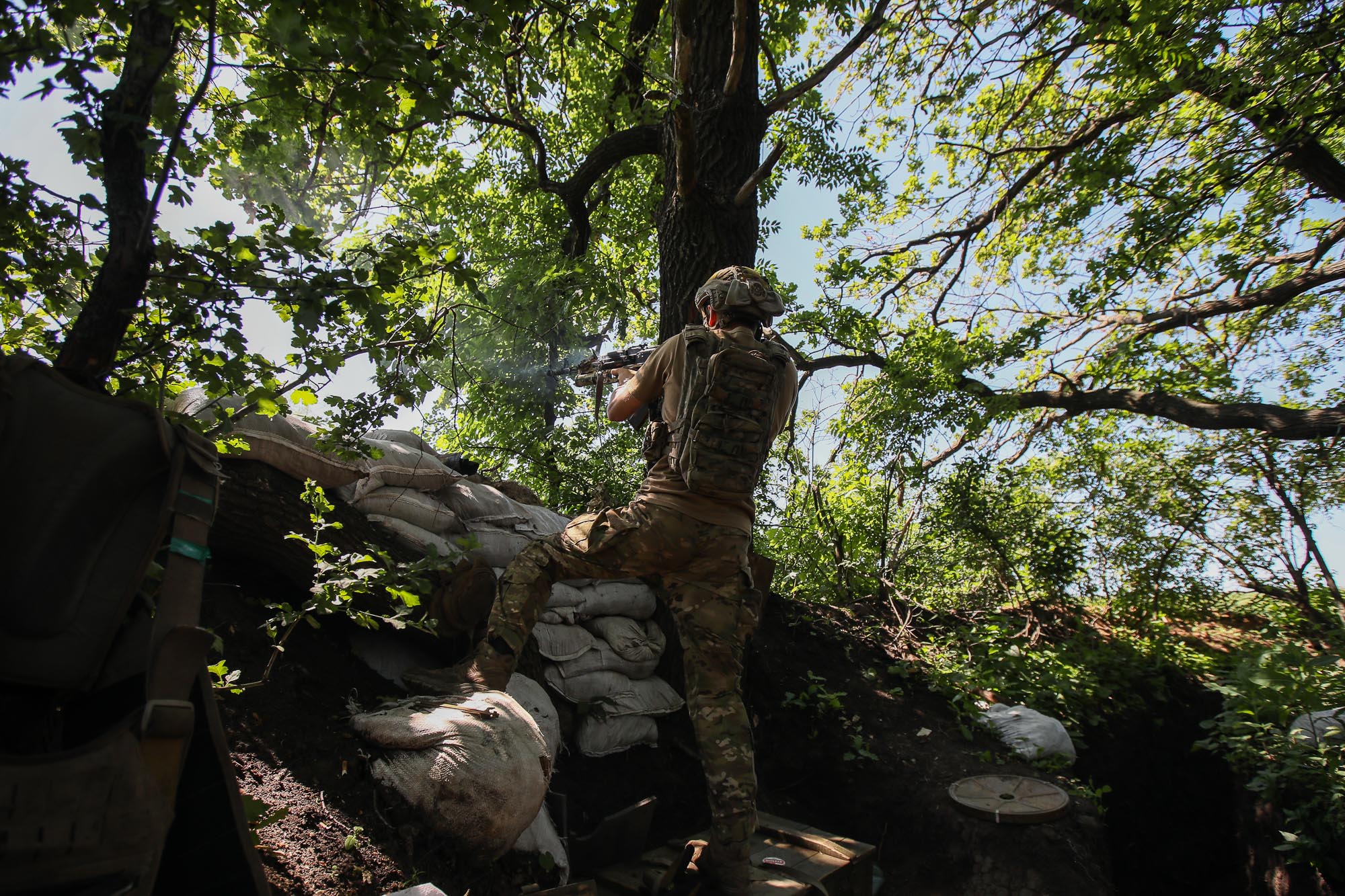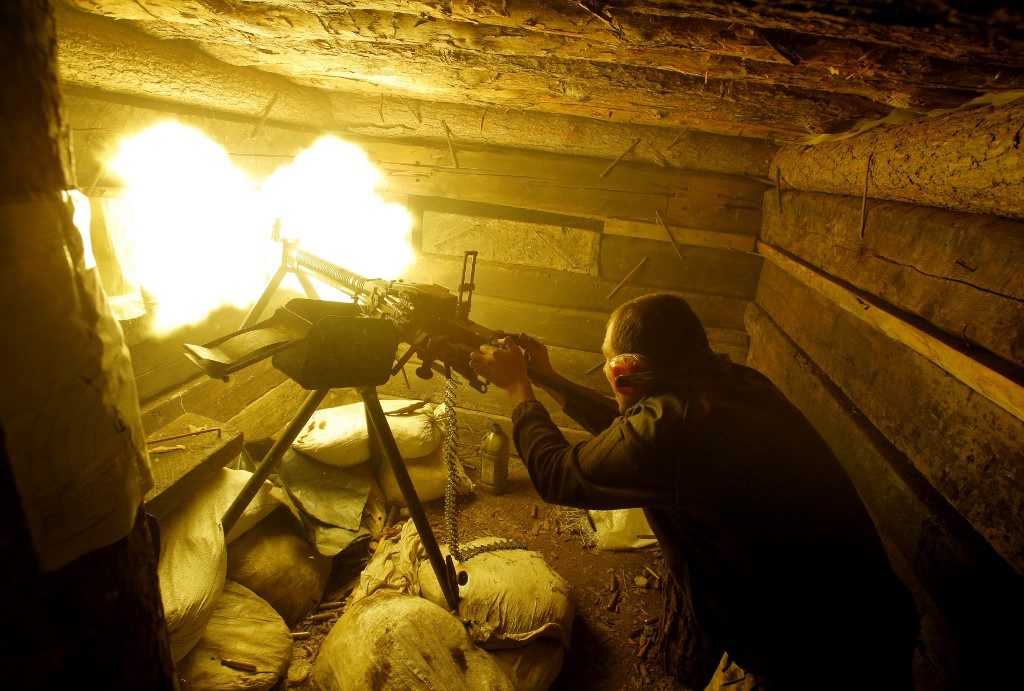A shadow fell over downtown Kyiv on the evening of Oct. 1 as angry crowds poured onto the central square of Maidan Nezalezhnosti. Hundreds of protesters including far-right activists also rallied near the Presidential Office, fiercely chanting “No to capitulation!”
Earlier, Russian media reported that Ukraine had agreed to accept the so-called Steinmeier Formula — a controversial German proposal to bring the Russian-Ukrainian war in the Donbas to a peaceful end, with local elections and regional autonomy.
To some, it looks like peace at any cost.
Many Ukrainians are lamenting that the formula is a deal with the Kremlin, and offers favorable terms to militants backed by Russia, which started a conflict in 2014 that has now claimed over 13,000 lives including at least 3,000 Ukrainian soldiers.
What happened in Minsk? Assessments ranged from a key breakthrough towards peace, to high treason, a demeaning surrender committed by President Volodymyr Zelensky.
The formula got the signatures of former president and Ukrainian envoy to the Minsk negotiations Leonid Kuchma and the Kremlin. But it is Russia and its proxies in Ukraine that are expected to enjoy the outcome of local elections in the occupied Donbas. The notion of broad autonomy is expected to create more questions than answers.
The diplomatic struggle to end the war in Donbas could now be in its endgame. But the formula does not address many key demands on the Ukrainian side. There is still uncertainty over the status of Ukraine’s border with Russia, and the unresolved presence of Russian-armed militants in the region.
To many, it looks as if Kyiv has backed itself into a corner.

Ukrainian soldiers stand in a dugout on the front line, near Avdiyivka, in Donetsk region on March 29, 2019, as a war with Russian-backed separatists in the east of the country drags on. (AFP)
Badly defined
The so-called Steinmeier Formula was proposed by Germany’s then-Foreign Minister Frank-Walter Steinmeier in 2016, to reinvigorate a hopelessly stalled Minsk peace process.
It envisaged holding local elections in Russian-occupied Donbas under Ukrainian law, with the supervision of the Organization for Security and Cooperation in Europe (OSCE). Should the OSCE recognize the elections free, fair, and democratic, the “special territorial status” of Donbas envisaged by the Minsk talks would take effect, giving the separatist territorial autonomy inside Ukraine.
According to the 2014 Minsk protocol, autonomy includes the right to have “people’s militia formations” (in fact, their own armed forces), to have cross-border cooperation with Russia, to appoint prosecutors and judges “under special procedure,” to facilitate the use of Russian language in public domains, and to enjoy privileges over state budget allocations.
Ukraine signed the Minsk protocol in 2014–2015 in the wake of disastrous military defeats at Ilovaisk and Debaltseve.
Back in 2016, then-President Petro Poroshenko endorsed the Steinmeier proposal as an acceptable solution to the Minsk stalemate, but ever since then, it saw little daylight — until Oct. 1, 2019.
The wording is ambiguous on whether the Russians would withdraw, if militant forces would disarm and disband and if Ukrainian media, observers and political parties would be allowed into the region. The formula only details the conditions under which the region would gain permanent, broad autonomy.
According to the document, the elections must be held in compliance with Ukrainian law. And at 8 p. m. local time on the election day — presumably immediately after the closing of all polling stations — the currently-occupied Donbas would be provided with a provisional “special territorial status” envisaged by already-existing law approved by the Ukrainian parliament as far back as in September 2014 (as part of the Minsk process) and formally renewed each year since then.
OSCE monitors supervising the polling would then weigh in. If they found the election to be fair and in line with international standards, the provisional law would become permanent.
Critics say the formula legalizes the occupation of the Donbas and turns it into a deadly Trojan horse under Russian control.
The Presidential Administration did not come up with a better solution than holding a chaotic 11-minute-long briefing with Zelensky. The ‘Steinmeier Formula’ letter to the OSCE signed by Kuchma was officially published the following day on Oct. 2.
Zelensky has hope
Zelensky said that the fact that the formula was approved does not mean he gave up on expelling Russian forces from the Donbas.
Speaking during the blitz briefing on Oct. 1, he called the formula “the biggest boogeyman of recent weeks” and said that it was not meant to deal with Ukrainian control of the region or Russian withdrawal before elections.
Zelensky repeatedly stated he would not consent to any elections in the region unless all non-Ukrainian armed forces were gone.
“This means that there can be no elections at machine-gun points,” he said. “If someone is out there, there will be no elections.”
As elections must adhere to Ukrainian law, Kyiv could reclaim its uncontrolled border with Russia, he added. Russia’s withdrawal will be discussed during an upcoming Normandy Four meeting of Russia, Ukraine, Germany and France.
The president also said that the provisional law on special territorial status for Donbas would expire after Dec. 31, 2019 and parliament would make new legislation.
“In this new law, no “red lines” will be crossed,” Zelensky said. “Therefore, there can be no capitulation.” He did not specify what the red lines were.
Bohdan Yaremenko, a lawmaker with Zelensky’s party Servant of the People, added some more clarity on Oct. 2, saying that the presidential team sees a total ceasefire, a prisoner exchange, and Ukrainian control over the territory and the border as indispensable preconditions to elections.
“No one has any doubts that this is not the war’s end,” Yaremenko said.
“But those steps decided directly by the Russian president can indicate Russia’s readiness to make arrangements.”

Ukrainian President Volodymyr Zelensky looks out of the army entrenchment at Russia-backed forces near Stanytsia Luhanska in eastern Luhansk Oblast on May 27, 2019. (The Presidential Administration of Ukraine)
Heavy backlash
Nonetheless, the decision drew fierce criticism from Zelensky’s political opponents.
Ex-president Poroshenko, who is currently leading the 27-seat European Solidarity faction, spearheaded the attacks, despite having endorsed the formula since 2016 and claiming that the Minsk process had “no alternatives” throughout his presidency.
In numerous tweets sent starting from Oct. 1, Poroshenko dismissed the proposal as “Putin’s formula” invented in the Kremlin and serving Russia’s interests. He called it legitimizing the Russian occupation of the Donbas and Crimea, and making the Donbas “an anchor blocking Ukraine’s aspirations towards European and Euro-Atlantic aspirations.”
The backlash intensified as Russian-backed militants on Oct. 2 said that they refused to recognize Zelensky’s lead in the peaceful settlement.
“It will be we who decide the language we speak, what kind of economy we have, how our judicial system will be formed, how our people’s militia will be defending our citizens, and how we will be integrated into Russia,” Donbas militant leaders Denys Pushilin and Leonid Pasechnik were quoted as saying by Russian media.
They added that “Kyiv authorities will not get any sort of control over the border (with Russia)” and claimed that they must approve any law on special territorial status.
Popular protests in Kyiv and other Ukrainian cities resumed through Oct. 2, although much of the Ukrainian public appeared to be confused about the poorly explained deal.
According to a poll published by the Rating Group pollster on Oct. 2, as many as 60 percent of Ukrainians hesitated to give their appraisal of the formula, while 23 percent opposed it and only 11 percent endorsed it.

A Ukrainian soldier engages the enemy in the war zone near the town of Novoluhanske, eastern Ukraine, on June 14, 2019. (Volodymyr Petrov)
‘No illusions here’
Paris, Berlin and London welcomed the formula, but so did the Kremlin.
Minsk negotiators agreed to launch another round of mutual withdrawal of manpower and weapons near the towns of Petrivske and Zolote in Donbas, and discussed the chances of another big prisoner exchange between Ukraine and Russia.
The decision reportedly paved the way for another Normandy Four meeting of France, Germany, Ukraine, and Russia, likely to take place in Paris sometime in the future.
“We have achieved progress, but many further steps are needed,” said German Chancellor Angela Merkel on Oct. 2 in Berlin. “This doesn’t mean we can lift sanctions (against Russia), but there are preconditions for that.”
The present situation gives few grounds for optimism — even if Kyiv still has some hope.
“The Steinmeier formula has a lot of risk in it for Ukraine,” Michael Carpenter, senior director of the Penn Biden Center for Diplomacy and Global Engagement, told the Kyiv Post. “It’s a potentially dangerous move by Ukraine. “But if Ukraine plays its cards right, Zelensky could make this happen in a way that advances Ukraine’s interests.”
“The proof is in the pudding. If you have OSCE monitors, if you have Russian troops withdrawn and if there are no military or paramilitary thugs running around when the elections are held, one could envision that being traded for some enhanced autonomy that would not compromise Ukraine’s sovereignty or the reach of the central government.”
But Carpenter doubts that Russian President Vladimir Putin will comply. “From Putin’s perspective, it’s hard to see how he would agree to that sort of arrangement because it would undercut Russian influence in Ukraine.”
“I think Zelensky is right to test Putin’s mettle, but he has to be very careful. Control of borders and restoration of the rule of law in Russia-occupied Donbas is central to all of this.”

Ukrainian soldier fires with a heavy machine gun during a combat with Russia-backed separatists on the front line near Gorlivka, Donetsk Region on Sept. 28, 2019. (AFP)
Glen Grant, retired British Army Colonel and former adviser to Ukraine’s Defense Ministry, also suggests Zelensky be extremely careful in making deals with the devil.
“There is no clarity of what Russia is saying or doing on this issue and there appears little to show for this move,” Grant told the Kyiv Post.
“The facts against Russia are stark. There has been no reduction in attacks in Donbas — in fact, the reverse. There has been no movement on returning Crimea, no improvement in the conditions in the Sea of Azov or the Black Sea. The nuisances from Russia continue worldwide.”
“I hope that there is a clear policy about this agreement that is not just one-sided concessions. Hopefully, the President will not gain tactical success in Donbas for strategic failure later. This is a dangerous game for national survival being played with an evil and cunning opponent who seeks to destroy Ukraine. There must be no illusions here.”
Mattia Nelles, an expert with the Center for Liberal Modernity, a Berlin-based think tank, believes many crucial questions are yet unanswered, “and the devil is in the details.”
“The Formula does not address under which exact circumstances the local elections are to be held and when,” he told the Kyiv Post.
“The president stated his interpretation of it by saying that there can be no ‘elections at gunpoint’ but that alone is insufficient. So, will the Ukrainians or the OSCE get control of the border to Russia?”
Nelles said that Zelensky’s drive for peace is laudable but Ukraine should tread carefully.
“A return of the occupied Donbas might be a poisonous and extremely costly gift by Russia, if it remains in control of its proxies there. Ukraine now, more than ever, needs allies that check any of such overtures and ensure that Ukraine’s territorial integrity will not be sacrificed so that the some in the West can return to business as usual with the Kremlin.”
Kyiv Post chief editor Brian Bonner contributed to this story.
